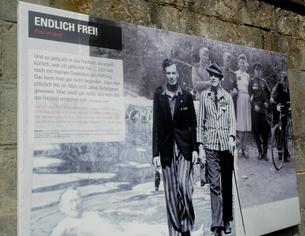The entire world commemorates the end of the World War II this month; Germany does it too on May 8. The horror is over. But we should also look back and see what happened 70 years ago.
This will not be a Second World War history lesson, but a story which deserves to be brought to light, a story which started long before the WW II – Sachsenhausen Massacre.
“… and there I saw this horrible misery, I saw the barracks, saw the people starved into skeletons – almost naked. That was in May. […] Then we were led on. I saw the piles of hair, the piles of spectacles and shoes, and I was so devastated, that I thought – and still think today – what an unbelievable crime happened there … (Helega Heinrich, Oranienburg)”
This quote leads the way towards Sachsenhausen National Memorial once paved with terror, crimes and sorrow. Half a century passed since the Death March in 1945, but we could never forget what happened behind these gates. I heartened myself to visit this concentration camp expecting to discover a very powerful piece of history, one which is crucial for the humankind. I did not foresee though the atrocities formerly enclosed between these walls.
I could probably read thousands of books and research even more thesis about the Nazi regime and its victims, but I believe a tour across this triangular fortress brings an additional perspective of the historical events. I do not want to reveal all the aspects nor to bombard you with too many details. I chose instead to illustrate my own understanding and let the facts and people’s testimonials tell the story – it is a winding thread across Sachsenhausen’s alleys, but if you are willing to know your past you should follow it.
Massacre under people’s eyes
Unlike the later concentration camp at Sachsenhausen, that of Oranienburg stood in the middle of town on the main road to Berlin, where locals and travelers could glimpse inside.
More than 200,000 people considered to be political opponents of the Nazi regime were imprisoned in the Sachsenhausen Concentration Camp between 1936 and 1945. In the long run, place was packed with people defined by National Socialists as racially or biologically inferior.
In the final days of World War II, the Red Army of the Soviet Union approached the concentration camp at Sachsenhausen and the prisoners were evacuated. The following actions remain known as the “Death March” where 3,000 who were too weak or sick to travel were left behind.
“The columns marched between 20 and 40 kilometers a day in cold wet weather and slept outdoors. In each column prisoners dragged wagons loaded with the belongings of the SS men. Since the streets were filled with refugees and army units, the columns moved forward very slowly. Following orders to kill or acting on their own initiative, SS men shot those who lagged behind or prisoners who tried to find stored potatoes and turnips to feed themselves. It is unlikely that the plan was to drive the prisoners to the Baltic Sea or as the former camp Commandant Anton Kaindl stated during the Soviet Sachsenhausen trial in 1947 “to drive them onto barges out to sea and let them sink.”
The prisoners’ enclosure at the Sachsenhausen concentration camp was built in the shape of a triangle, as shown in the center of the map above. Below the triangle is the location of the SS camp where the guards and the Commandant lived and where the administrative offices were located. It takes at least three good hours to visit the entire camp, considering the New Museum, the former crematorium and the time you are lured to over analyse the items exposed inside.
Paul Sakowski who was interned in Sachsenhausen Concentration Camp in 1938 described his work in the crematorium:
‘‘Up to seven corpses went into once oven. When they were incinerated, the next corpses were put into the oven, without the ashes of the previous corpses being taken out of the oven. The ashes were not taken out of the oven until the ash pan was full. That was usually the case after twenty to twenty-five corpses had been incinerated. The ashes were then put in the ash bunker […] “.
- 5 Innovative Tools and Untapped Platforms to Help You Ace Your Finals - May 1, 2017
- StartUp2017 – How to start a food business - January 16, 2017
- The Lean Start-up Series – From ideation to the “AHA” moment - December 8, 2016
